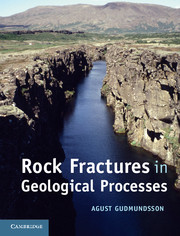Book contents
- Frontmatter
- Contents
- Preface
- Acknowledgements
- 1 Introduction
- 2 Stress
- 3 Displacement and strain
- 4 Relation between stress and strain
- 5 Loading of brittle rocks to failure
- 6 Stress concentration
- 7 Theories of brittle failure of rocks
- 8 Extension fractures and shear fractures
- 9 Displacements and driving stresses of fractures
- 10 Toughness and fracture mechanics
- 11 Field analysis of extension fractures
- 12 Field analysis of faults
- 13 Evolution of extension fractures
- 14 Evolution of faults
- 15 Fluid transport in rocks – the basics
- 16 Fluid transport in faults
- 17 Fluid transport in hydrofractures
- Appendix A Units, dimensions, and prefixes
- Appendix B The Greek alphabet
- Appendix C Some mathematical and physical constants
- Appendix D Elastic constants
- Appendix E Properties of some crustal materials
- Index
- References
15 - Fluid transport in rocks – the basics
Published online by Cambridge University Press: 05 June 2012
- Frontmatter
- Contents
- Preface
- Acknowledgements
- 1 Introduction
- 2 Stress
- 3 Displacement and strain
- 4 Relation between stress and strain
- 5 Loading of brittle rocks to failure
- 6 Stress concentration
- 7 Theories of brittle failure of rocks
- 8 Extension fractures and shear fractures
- 9 Displacements and driving stresses of fractures
- 10 Toughness and fracture mechanics
- 11 Field analysis of extension fractures
- 12 Field analysis of faults
- 13 Evolution of extension fractures
- 14 Evolution of faults
- 15 Fluid transport in rocks – the basics
- 16 Fluid transport in faults
- 17 Fluid transport in hydrofractures
- Appendix A Units, dimensions, and prefixes
- Appendix B The Greek alphabet
- Appendix C Some mathematical and physical constants
- Appendix D Elastic constants
- Appendix E Properties of some crustal materials
- Index
- References
Summary
Aims
To understand fluid transport in the crust in general, and in rock fractures such as faults and hydrofractures in particular, some of the basic principles of fluid transport in porous and fractured media must be given. These principles include Darcy's law for flow in porous media and the cubic law for flow in fractures. Only the basic definitions and formulas that are needed in this and subsequent chapters are given. There are many excellent books on hydrogeology and fluid flow in porous media where the details can be found. The main aims of this chapter are to:
Explain Darcy's law for fluid flow in porous media.
Explain the cubic law for fluid flow in fractures.
Present the model for fluid flow in a single set of fractures.
Present models for fluid flow in orthogonal sets of fractures.
Present some basic general results on fracture-related permeability.
Fluid transport in porous and fractured rocks
Fluid flow in crustal rocks is through pores, through fractures, or, most commonly, through both pores and fractures. How fluids are transported is of great academic and applied interest; understanding all kinds of fluid reservoirs depends on knowing and, preferably, being able to predict their permeabilities and fluid-transport or hydromechanical properties. Fluid flow in the crust is primarily through porous or fractured media, or a mixture of both (see Appendix E.2 for the physical properties of some crustal fluids).
- Type
- Chapter
- Information
- Rock Fractures in Geological Processes , pp. 466 - 495Publisher: Cambridge University PressPrint publication year: 2011



